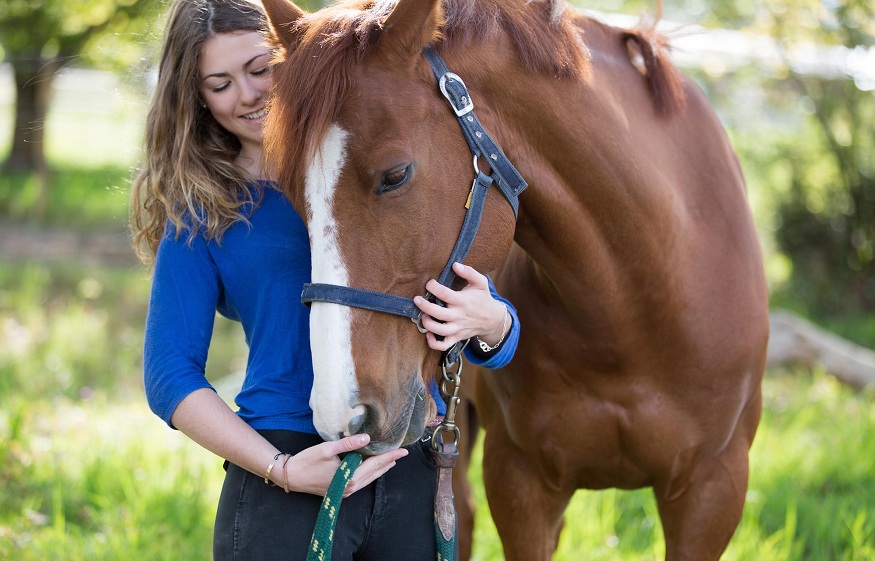
Horse health, grooming, and feeding need a lot of effort and attention. You may have many health and safety inquiries when you first buy a horse.Luckily, pets communicate both ways. Over time, you’ll learn its good and poor reactions to your actions.
I’ll also offer nine horse-care tips.
1. Give Adequate, High-Quality Food and Water
The first step in horse care is feeding it. Provide your pet with fresh water and hay at all times.Horses’ poor digestive systems are widely known. Therefore, it prefers grazing throughout the day than three square meals. If you can’t feed fresh grass or pasture, hay and grain will do.However, foals, mares, seniors, and racehorses need vitamins and minerals. Before choosing a diet, consult your vet.Make sure horse hay is good before feeding it. Mold or other odd smells indicate discard. The occasional salt lick and fresh, green, and soft hay are what every horse wants. Treat your pet to an apple, sugar cube, or carrot sometimes.
2. To Tidy Up Your Horse: Clip Nails
Grooming a horse daily is best for the animal. Regularly wipe the animal’s body of dirt, dust, and mud and examine any wounds, scratches, or blisters.The grooming process increases blood flow and removes sweat from the horse. Your time together will strengthen your bond. Your smart horse will appreciate your efforts if you treat it nicely.Horse grooming takes time, effort, and skill. In the beginning, you need help, research, and effective tools. The following are needed to begin:
- Spruce brush anatomy
- Comb with rubber coating
- Brush your hair.
- Hoof sponge Pick
- Scrubbing your face
Don’t wash your horse daily. Riding an animal in the rain will cover the rider in muck. In that case, bathe a horse with mild pet shampoo and warm water.Always avoid shampooing or soaping the horse’s eyes. Instead, clean its face with a damp, gentle towel.
3. Clean the Stable
Horses, like humans, like spacious homes to roam and exercise. The average animal stall is 12 square feet (3.7 square meters).Keep stables clean at all times. Daily cobweb, dust, manure, and rubbish removal should be a habit. Your animal needs a dry, urine-free floor to avoid hoof diseases.Frequently change linens. Equine nappers may get by on their feet, but they need a clean, large place to rest. Hay dust in vents should be checked routinely. Cables, nails, and unsteady boards should not be in a stable. Insect repellents prevent fly and bug infestations. Check your stuff in the stable. Change filthy saddle blankets and padding, condition leather, and inspect tack regularly.
4. Improve Relationships and Communication in Closer Relationships
A horse won’t approach or touch you unless it’s comfortable. To train or care for an animal, you must gain its trust. Fortunately, there are various ways to gain your new friend’s trust.
Practice Patience
Approaching a horse for the first time requires calm confidence. Take a few slow steps toward the animal. The horse may flee if the initial contact is too quick. Let it scent you, then offer a treat.After making contact, move slowly. Slow down when training and riding. It may take weeks for the horse to respond to your orders and progress.
Whisper Softly When Petting Your Horse
How you walk, stand, and talk to your horse can reveal a lot about you. You can bet the farm that your horse knows you better than himself.Prepare for horse time with self-control. Maintain calmness and a firm but gentle approach. A sympathetic and encouraging trainer is needed to help the animal learn.Most horses prefer human touch, so find out if yours likes scratching, massaging, or patting. Daily expressions of love and affection will be great.
5. Regular exercise
Most professionals agree that weary horses are happy. Horses need frequent exercise, but how much depends on their age, breed, and health.On average, animal training takes one hour per day. Regular exercise helps your horse build muscle, preserve the heart, back, and joints, and avoid weight gain.Remember that horses like routine. Try to release it from the stable at the same time every day and follow a fitness schedule that includes:
6. Weather protection
Shelter Needs
Even though most horses prefer cool summer days to hot ones, don’t leave them outside. Insulate and lock the stall’s windows. During winter and rainy seasons ensure your horse has weatherbeeta stable rugs to protect them from the rain and cold. Thus, you’ll have summer shade and winter protection for your pet.Use lightweight horses saddle pads and horse numnah blankets in hot weather. When it gets cold, use thicker ones to keep the horse warm.
Summary
Taking care of a horse means meeting its needs, keeping it healthy, and deepening your bond with it. You must also clean the stable, socialize the animal, and train it.e
